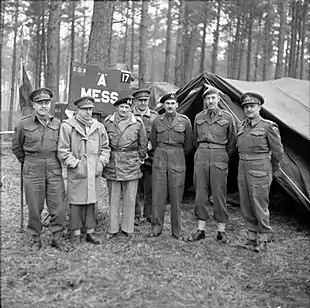Bruce Matthews (Canadian Army officer)
Major General Albert Bruce Matthews, CBE DSO ED (August 12, 1909 – September 12, 1991) was a senior Canadian Army officer and businessman in the 1930s. He rose to be the General Officer Commanding (GOC) 2nd Canadian Infantry Division during the Second World War, after campaigns in Sicily and Italy. He became noted for his personal bravery and the accuracy and reliability of the artillery under his command.[1] Post-war, his business career continued. In addition, he was active in the Canadian Liberal Party.
Albert Bruce Matthews | |
|---|---|
 Matthews (r) in February 1945 when Bernard Montgomery visited the Canadian troops | |
| Born | August 12, 1909 Ottawa, Ontario, Canada |
| Died | September 12, 1991 (aged 82) |
| Allegiance | |
| Service/ | |
| Years of service | 1928–1945 |
| Rank | Major General |
| Unit | Royal Canadian Artillery |
| Commands held | 5th Medium Regiment, Royal Canadian Artillery 2nd Canadian Infantry Division |
| Battles/wars | World War II Sicily Italy Normandy Scheldt Rhineland Netherlands |
| Awards | Distinguished Service Order Commander of the Order of the British Empire Honorary citizenship of the city of Groningen |
| Relations | Albert Edward Matthews (father) |
| Other work | Colonel commandant of the Royal Regiment of Canadian Artillery President Liberal Party of Canada |
Early life
Born 1909, his father, Albert Edward Matthews, was a prominent stockbroker with Liberal connections who became Lieutenant-Governor of Ontario in 1937. Bruce Matthews was educated at Upper Canada College in Toronto, later serving as President of its Board of Governors, and at Geneva University. He then joined the family firm.[1]
Matthews married Victoria Thorne in 1937; the couple had one child before the outbreak of war and, after Victoria had visited Matthews in Britain in summer 1940, there were twins in 1941, although Matthews did not see them until October 1945.
Military career
At first, in 1927, Matthews, was turned down for admission to the Royal Military College of Canada and he was also rejected by the Royal Canadian Navy Reserve due to his colour blindness. Nevertheless, in 1928, he joined the Non-Permanent Active Militia, 30th Field Battery, 3rd Field Brigade, Royal Canadian Artillery,[1] as a provisional lieutenant, qualifying as a lieutenant later that year. He was promoted to captain in 1933 and started a two-year militia staff course. In 1936, Matthews was appointed adjutant in the 7th Toronto Regiment of the Royal Canadian Artillery and in 1938 he commanded the 15th Field Battery, as a major.
War was declared in September 1939 and Matthews was posted overseas to the UK with the 1st Canadian Infantry Division in December. In the wartime army, Matthews rose steadily; commanding a battery in March 1940, then he raised the 5th Medium Regiment (as a lieutenant-colonel) in September 1941. After an appointment from September 1942 as counter battery officer at Headquarters, I Canadian Corps, in January 1943 Matthews was promoted to brigadier at the age of 33, the youngest at that time in the Canadian Army, and Commander, Royal Artillery, 1st Canadian Infantry Division.
Matthews' active service started in July 1943, landing in Sicily and directing the naval gunfire of HMS Roberts and later finding artillery locations, while under direct enemy fire, for the assault on Agira during the Sicily campaign.[1] In September 1943, his Italian mainland campaign began: he was later awarded the DSO. He returned to the UK in January 1944, having been transferred to the II Canadian Corps as CCRA, regarded as the "second most senior job for a gunner in the Canadian Forces". II Corps was activated in Normandy on July 11, 1944 and participated in several actions (Operations Atlantic, Spring, Totalize and Tractable) in the Battle of Normandy. Matthews developed the artillery firing plans for each of these operations.[1]
Matthews' coordination of the large-scale artillery support in Normandy and Walcheren showed him to be a highly skilled gunner.[1]
In November 1944, Matthews was promoted to major general and appointed GOC 2nd Canadian Infantry Division, bringing it back to high operational efficiency after its gruelling battles on the Scheldt. The Division took part in the Rhineland battles (Operations Veritable and Blockbuster) battles in February and March 1945. The Division advanced from Kalkar, through the Hochwald and Xanten to Wesel, narrowly failing to prevent the demolition of the Rhine bridges by the retreating Germans.[1]
Once across the Rhine, Matthews' Division liberated the northern Netherlands and then made a rapid 150-mile move to guard XXX Corps' right flank on the Weser. The Canadians captured Oldenburg and they were approaching Wilhelmshaven when hostilities ceased on May 5.[1]
Post war
Forgoing a promising military career, Matthews returned to Canadian business life and he was appointed to directorships with Excelsior Life, Dome Mines and Standard Broadcasting. He was chairman of Massey-Ferguson from April 19, 1978 to December 12, 1978 and president of the Argus Corporation. In politics, he served as President of the Liberal Party of Canada in the late 1950s and early 1960s.[1]
He served as Colonel commandant of the Royal Regiment of Canadian Artillery from 1964 to 1969.[1]
Matthews was considered for the post of Governor General but his strong party allegiance precluded him.[1]
References
- Twiston Davies, David (1996). Canada from afar: the Daily Telegraph book of Canadian obituaries. The Daily Telegraph. pp. 147–148. ISBN 1-55002-252-0.
- Granatstein, Jack (1993). "6". The Generals. Stoddart Publishing. ISBN 0-7737-2730-2.
External links
| Military offices | ||
|---|---|---|
| Preceded by Charles Foulkes |
GOC 2nd Canadian Infantry Division 1944–1945 |
Succeeded by Division disbanded |
| Party political offices | ||
| Preceded by Duncan Kenneth MacTavish |
President of the Liberal Party of Canada 1958–1961 |
Succeeded by John Joseph Connolly |